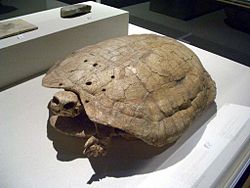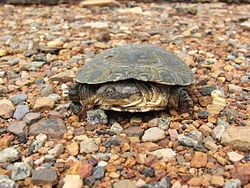There are fourteen extantfamilies of theorder Testudines, an order ofreptile. The testudines are some of the most ancient reptiles alive, with only thetuataras considered more primitive. There are approximately 300extant species and 97genera of testudines, split into twosuborders: theCryptodirans and thePleurodirans. The distinction between these two suborders is based on the mode in which they cover their head and neck. The Pleurodirans, also called the side-necked turtles, have long necks, and fold them sideways to align them with the shell. ThePelomedusidae andChelidae are the only extant families of pleurodires. The Cryptodirans pull their neck straight back to conceal their head within the shell. TheCarettochelyidae,Cheloniidae,Chelydridae,Dermatemydidae,Dermochelyidae,Emydidae,Kinosternidae,Testudinidae andTrionychidae are all cryptodires, although the ability to retract the head has been lost in the sea turtles (Cheloniidae and Dermochelyidae). A third order, theParacryptodirans, are extinct.[1][failed verification][dubious –discuss]
Reptiles are classified according to the pattern offenestration in the temporal region of theskull. Testudines are placed in the subclassAnapsida because they lack fenestration.[2] There are suggestions that this lack of fenestration is a secondary characteristic and that turtles belong inDiapsida.[3]Both sides cite strong evidence, and the conflict has yet to be resolved.[4][5][6] The shell of testudines distinguishes them from other vertebrates. The shell is not anexoskeleton, but a modifiedribcage and part of thevertebral column. Because of the shell, the pectoral and pelvic girdles are located within the ribcage. The limb bones are also modified to accommodate to the shell.[1]
The earliest known turtles are from fossils in theUpper Triassic. These fossils are nearly indistinguishable from modern turtles anatomically. In these early fossils (mostly of the genusProganochelys), the teeth have already been lost, and akeratin beak is suggested by themandibles. Important differences between Proganochelys and modern turtles are the presence of the palatal teeth (lost in modern species), the inability to retract the head within the shell, and the lack of a trochlear pulley in the jaw closing anatomy.[1]
The following lists the family—the Latin name of the family, date in which the species was formally described and classified, and the binomial authority on the species; the number of genera belonging to the family; the name or names commonly used; an example species and an example image.
| Cryptodira – 11 families, 74 genera, over 200 species | ||||
| Family[7] | Genera[8] | Common name(s) | Example species | Example image |
|---|---|---|---|---|
| Carettochelyidae Boulenger, 1887 | 1 | Pig-nosed turtle | Pig-nosed turtle (Carettochelys insculpta) |  |
| Cheloniidae Oppel, 1811 | 6 | Sea turtles | Green sea turtle (Chelonia mydas) |  |
| Chelydridae Gray, 1831 | 2 | Snapping turtles | Alligator snapping turtle (Macrochelys temminckii) |  |
| Dermatemydidae Gray, 1870 | 1 | Central American river turtle | Central American river turtle (Dermatemys mawii) |  |
| Dermochelyidae Fitzinger, 1843 | 1 | Leatherback sea turtle | Leatherback sea turtle (Dermochelys coriacea) |  |
| Emydidae Rafinesque, 1815 | 12 | Pond turtles, terrapins, and sliders | Red-eared slider (Trachemys scripta elegans) |  |
| Geoemydidae Theobald, 1868 | 24 | Asian leaf turtles, roofed turtles, and Asian box turtles | Amboina box turtle (Cuora amboinensis) |  |
| Kinosternidae Agassiz, 1857 | 4 | Mud and musk turtles | Common musk turtle (Sternotherus odoratus) |  |
| Platysternidae Gray, 1869 | 1 | Big-headed turtle | Big-headed turtle (Platysternon megacephalum) |  |
| Testudinidae Batsch, 1788 | 12 | Tortoises | Aldabra giant tortoise (Geochelone gigantea) |  |
| Trionychidae Fitzinger, 1826 | 14 | Softshell turtles | Spiny softshell turtle (Apalone spinifera) |  |
| Pleurodira – 3 families, 16 genera, over 60 species | ||||
| Family | Genera | Common names | Example species | Example image |
| Chelidae Gray, 1831 | 15 | Austro-American sideneck turtles | Common snakeneck turtle (Chelodina longicollis) |  |
| Pelomedusidae Cope, 1868 | 2 | Afro-American sideneck turtles | African helmeted turtle (Pelomedusa subrufa) |  |
| Podocnemididae Gray, 1869 | 3 | Madagascar big-headed, big-headed Amazon River turtle and South American sideneck river turtles | Madagascar big-headed turtle (Erymnochelys madagascariensis) |  |